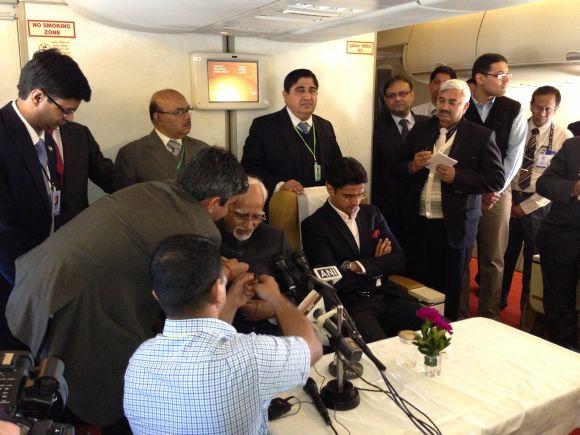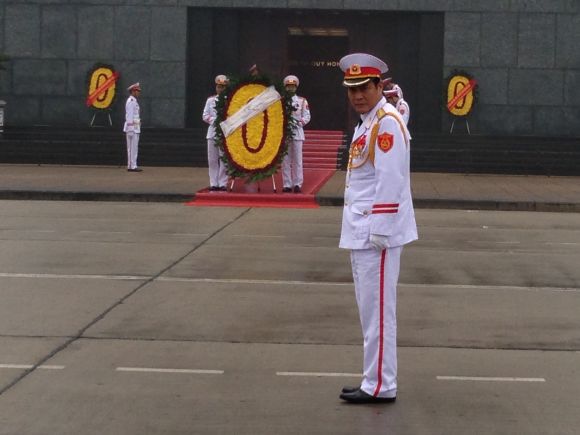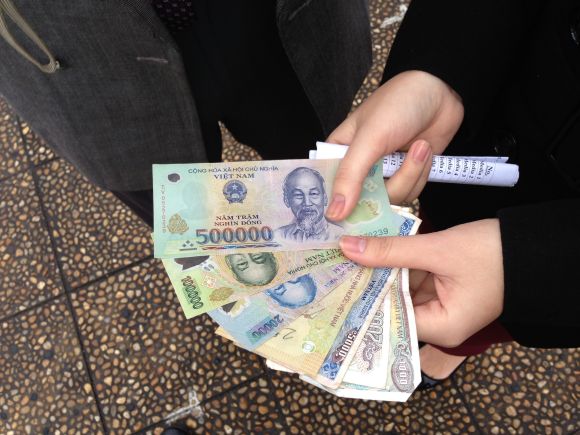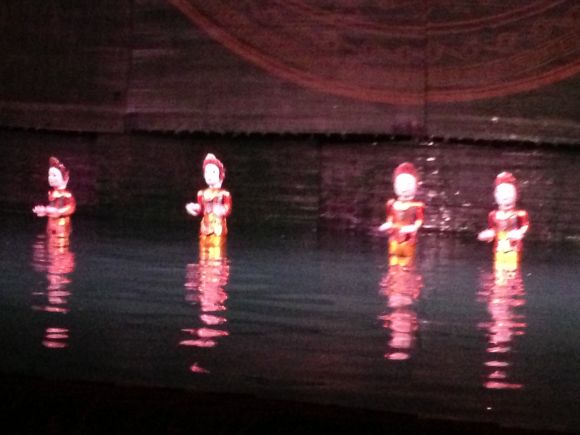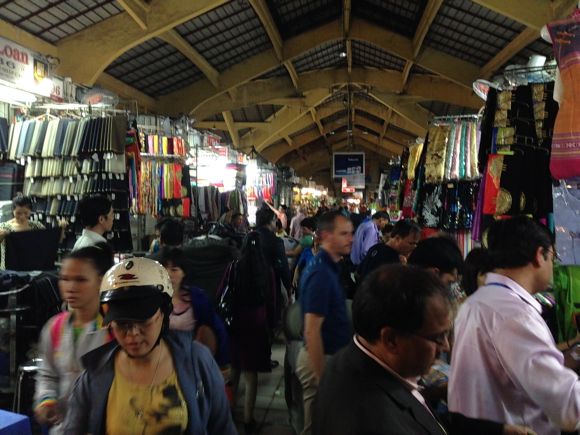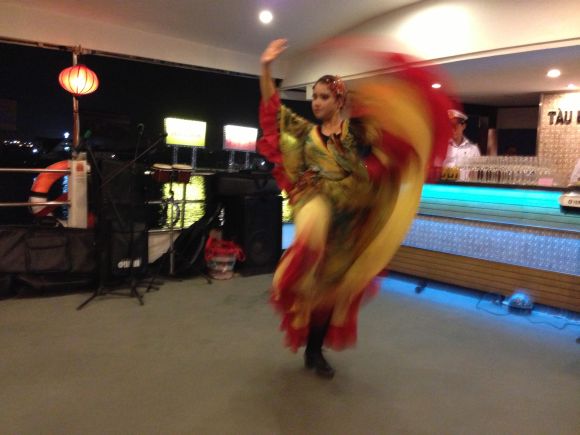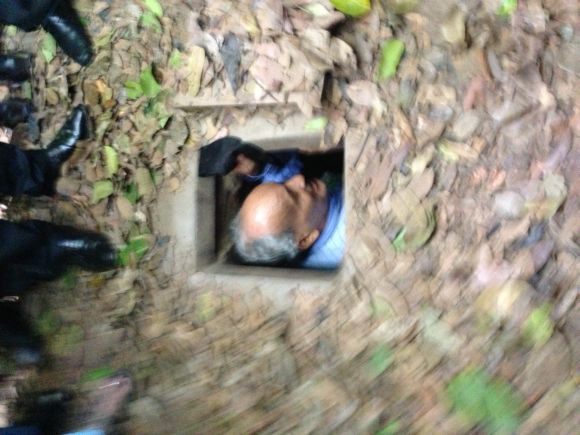 | « Back to article | Print this article |
In the skies with the Vice President
Rediff.com's Saisuresh Sivaswamy, who travelled with Vice President Hamid Ansari as part of his media entourage during his recent trip to Vietnam, shares his experiences.
The Vice President flies abroad on official trips, like to Vietnam this week, by the same special Air India flight as the prime minister and the President, but there the similarities end, at least as far as the PM's travels are concerned.
The veep's flight too takes off from the Palam Air Force base near Delhi's domestic airport, but the security rigour is much lighter. With the prime minister you are made to open your suitcases, explain its contents, boot your laptop to show that it is not a bomb in disguise, click a photo with your camera, power your mobile, etc. The vice president's trip had none of this scrutiny. The suitcases are checked in, identified, and sent to the plane. May we add, for none the worse as far as the VIP's safety is concerned?
On board the media gets VIP treatment, is made to occupy the redone business class seats, while the high-power delegation takes the front section. The rest of the delegation, like junior-level MEA functionaries, etc, bring up the rear.
But it is not the seating arrangements as much as the food that is served on board the Air India aircraft that is of interest. Believe us when we say that it is invariably top-notch, both in terms of quality of the food as well as service.
This time, there was something unusual when we flew from Hanoi to Ho Chi Minh City, formerly known as Saigon. The menu included freshly-made, authentic rotis. Now where does Air India source rotis in Vietnam, we wondered.
Thus we found that even as the MEA sends its advance teams to prepare for the VIP visit, so does the national carrier. Four chefs had been flown ahead of the visit to prepare the food complete with fresh Indian ingredients. While local talent is used for cutting the vegetables, meat, etc, the Indians chefs, we learnt, kept the flag flying. Burp.
Please click NEXT to read further...
Vietnam's Delhi
Hanoi, we were told, would be cold this time of the year but none of us expected the constant drizzle and overcast skies that refused to relent. Not only did the weather cast a spell on one's mood, it also put paid to grandiose plans drawn by many to explore the Intercontinental's many facilities.
While the city's vistas, traffic and general appearance drew parallels with India, its power centre nature gave it the air of Delhi. But our Rashtrapati Bhavan, we must say, is a lot grander than Hanoi's presidential palace.
The vice president's travels overseas are symbolic in nature, just as the President's are. So you can't expect any policy pronouncement and such stuff. So why fly, one may ask and be fully justified. But the visits by heads of state and his deputy also convey a message, a reminder that the ties have not been relegated to the backburner and the host country remains in one's calculations.
But journalists being what they are, would dig up any issue in the hope of a catchy headline, despite knowing fully well that the head of state cannot make any policy statement or be seen to be at loggerheads with the government of the day. Despite knowing this, we will nevertheless pursue our quest.
Thus, Hamid Ansari was asked whether Air India would start direct flights to Hanoi, and he politely said the decision will have to be the carrier's MD and the aviation minister's. What does he think of solutions to the rape problem, like chemical castration? It is up to the government to decide on it, replied the veep.
Oh well, such are the foibles of our tribe...
Please click NEXT to read further....
Where is Ho Chi Minh's body?
Ansari's first official deed in Vietnam was to lay a wreath at the Ho Chi Minh mausoleum in Hanoi on Tuesday morning. This was also a symbolic gesture, as the wreath is given to him and he places it near the outer wall of the imposing structure. This was followed by a quick walk through the mausoleum, past the revolutionary leader's mummified body and out.
But is it really Ho Chi Minh's body lying embalmed in the mausoleum? Lucy, our Vietnamese interpreter, dropped a bombshell on us ignorant souls by saying no, it was only a replica, probably made of plaster of paris or ceramic. The real body is kept in a mountain cave outside Hanoi, she says.
Jaswant Singh, an MEA man, pooh-poohed this theory. What nonsense, he dismissed Lucy's claim, of course it is Ho Chi Minh's body in the mausoleum, in fact it is sent to Russia every year for preservation. She however stood her ground, saying that all the locals know it is not his body, nor is it sent to Russia, but the foreigners continue to believe it to be Ho Chi Minh inside.
Now that we mention it, yes, the body did look unnaturally porcelain, we think...
Vietnam is among the countries whose currency is weaker than India's and while we knew that the Dong is 20,800 to a dollar, we didn't expect the practical fallouts of this ratio.
The rupee, thus, is equal to around 400 Dongs or so. The notes, we saw, were made of thin plastic, and there were no coins in circulation.
So if you tried to exchange 100 dollars you returned as a millionaire twice over. Or the prices could initially stun you till you get used to it. A plate of pasta at our hotel could cost two lakh Dong! To not shock the tourist, some establishments drop the last three zeroes and say in the fine print that the prices are in thousands of Dongs.
However, eoe unto you if you didn't read it and ended up buying something thinking it to be dirt-cheap.
Please click NEXT to read further...
Puppets on the water
There is no dearth of things to do for the diehard tourist in Hanoi, and travel websites are full of suggestions, ranging from the exotic (cobra blood, anyone? Maybe drink it with the heart still throbbing?) to the banal -- shopping. But one thing we would recommend is a visit to the water puppet show.
There are puppet shows and there are puppet shows but what is a water puppet show? Would the marionetteer stand in ankle-deep water while pulling the strings? Would the puppets be prancing in water? Our curiosity piqued, we decided to drop by after the evening's briefing was over, a time when journalists are given to contemplation over a full glass. It was one of the best things we've done on a VIP trip, never mind missing out on a desi eatery some others had piled on to or the mandatory shopping trip.
The water puppet show apparently is a traditional Vietnamese art, and has been preserved and presented by the Thanglong Water Puppet Theatre which we were visiting. It tells the story of Vietnam from days of yore, when legend and fact mixed seamlessly as it did in India, accompanied by the fetching voice of a couple of equally fetching women and some soulful music.
The audience comprised largely whites, who sat through the hour-long performance patiently and applauded when the cast revealed themselves for curtain call. Kiamon (thank you), Hanoi!
Exotic food is de riguer if you are visiting the south-east, and Vietnam is no exception. Mealtime would see a healthy spread, a lot of it vegetarian in deference to the media team's composition, and an effort is made to doff the hat at Indian fare, though not always with success. But since the effort is touching, it would be petty to cavil.
Journalists generally play safe at mealtime, and while the farthest I ventured out was to the sushi counter, at least one of us proved to be an intrepid adventurer. I discovered octopus meat at a counter and immediately alerted him and he rose to the challenge. As he chewed down the rubbery flesh, the verdict was immediate: Definitely interesting.
Please click NEXT to read further...
Oh to be in Saigon...
If Hanoi can be compared to our own Delhi -- you know, part grandeur being the capital, part old world, and some part of it dreary -- Ho Chi Minh City, or Saigon to give its legendary name, is clearly Mumbai: commercial capital, yes, but also lively and throbbing, with a larger number of firangs, mostly white.
Common to both cities in both countries: the chaotic traffic where you die another day. HCMC is also helped by the fact that it was always foreigner-friendly, and the fact that American forces used it as the base during their long offensive kept it alive in Western perception.
Unlike cold and wet Hanoi, HCMC was bursting with the sun, and the roads were illuminated during the night to mark spring. You could feel the spirit of the city, just as you can in Mumbai.
The government-run Hotel Rex, where the media was housed, was where the American press corps based themselves during their coverage of the Vietnam war. The Rooftop Bar, in fact, was where the media briefing was held every evening. Its name during those tumultuous days: Five O'clock Follies!
Hanoi or HCMC, one thing you cannot miss out on is the war museums. Given their long history of invasions by foreigners, who were all repelled by this doughty people never mind the size of the opponent, Vietnam has kept alive the memories of both its heroes from the ancient times as well as the incalculable damage suffered by it in defending its freedom, a lesson India, with its similar history of subjugation and liberation struggle, would do well to emulate.
While the war museum in Hanoi is a modest affair, and focuses heavily on its ancient techniques and medieval heroes, with one room devoted to Dien Bien Phu in which the French imperialists were given a bloody exit, there was no mention there of the bigger, more famous and recent war against a much superior enemy, at least as far as I could tell, barring the weaponry seized that lies outside the building.
For the American war you will have to visit the war museum in HCMC, which tells the horrors inflicted on the nation by America, including the devastating Agent Orange which is still wreaking havoc. The evidence is chilling, the narrative nauseating, the stories tearful. But remarkably, in the telling of its heroic defence, there is no rancour, there is no call for revenge or talk like '10 of their heads for one of ours'. In fact a large part of the patrons are white, quite a few Americans.
Jim B, as he called himself, said he was from the midwest, and what he saw at the museum stunned him. I mean, we were told we suffered heavily in the war, but I had no idea we did this to another free nation, he said.
Vice President Hamid Ansari too dropped by, and visited the area showing the widespread support to Vietnam during the war. He particularly visited the poster by the Communists of West Bengal, in Bangla, that said 'Victory to you, Ho Chi Minh!' We like.
Please click NEXT to read further...
Cruising down the Saigon
Another thing visitors to HCMC should do is to go on a river cruise. We did, and loved the experience, all thanks to the MEA which took us on it.
So what was special about this river cruise, you ask. Well, for one, it was just a bunch of journalists and foreign ministry officials letting their guard down away from the confines of work, and for another there were the cultural programmes that got featured on the cruise.
From crooners trying their hand at Indian (read Bollywood) songs, a female performer on the Vietnamese version of the iktara, to a flautist playing (of all things) Alisha Chinai's Made in India, to lissome lasses shaking their booty to Jai Ho! and a gamine girl dancing with fire -- it was all done in a spirit of abandon and sheer joie de vivre.
On top of it was the coruscating backdrop of the city skyline, plus free-flowing spirits followed by delicious food. No wonder the Vice President told the media corps the next day: "So I hear you folks had a wonderful time last night!"
Yes, we did, your excellency.
Please click NEXT to read further...
Wiggling through at Cu Chi camp
The last day of the trip saw early morning preparations to visit the Cu Chi camp to be in time to take in the experience, and pile on to the official carcade to get back to the hotel in time for the flight back. But traffic, that great leveller, put paid to the early arrival plans, and so we walked in with the veep's entourage plus Union minister Sachin Pilot and BJP member of Parliament Bhagat Singh Koshiyari among others.
Cu Chi camps are an intricate network of underground tunnels spread over 250 km, and were dug by the locals to resist first the French and then the Americans. They were built over a period of 20 years, painstakingly by hand, using locally available resources and genius. And yes, it was a sheer work of military genius.
The tunnels were narrow enough to allow only slightly-built Asian fighters to bend through, and variously provided a shelter from overhead bombings and assault, a place to recoup and strike back at the enemy, any number of booby traps, ventilation channels, nursing areas, a cooking area, plus plenty of decoys to mislead the enemy.
They were also unlit, the locals got by after memorising their way about, and tales abound of foes losing their way and meeting a horrific end. Thanks to the Cu Chi tunnels, the Viet Cong regained control of the surrounding villages at night from the all-present US army which was in charge during the day.
Naturally the tunnels are a matter of history and pride for the Vietnamese, and a few have been rendered "tourist-friendly".
Thus it was that when the official conducting us about asked if anyone would like to go down a tunnel and emerge from the exit 15 metres away, not many put up their hands. Koshiyari gamely went in, but before the trap door could shut on him was dissuaded by officials into coming out.
Leading veteran journalist R Rajagopalan to comment, "Sir now you are qualified to become BJP president, after all you have come up from below." Also descending into the tiny aperture in the ground was the OSD (PR), J S Singh.
At another tunnel, Ansari's wife Salma gamely went in as did the ever sharply dressed Pilot who, strangely, backed out after taking the first step. Perhaps for fear of ruining his designer togs?
The official taking us around said daily some 1,500 tourists visit the tunnels, including many Americans. And what do they say on seeing the horrors inflicted by their country in the name of freedom? "They say sorry," he laughed.
TOP photo features of the week
Click on MORE to see another set of PHOTO features...
